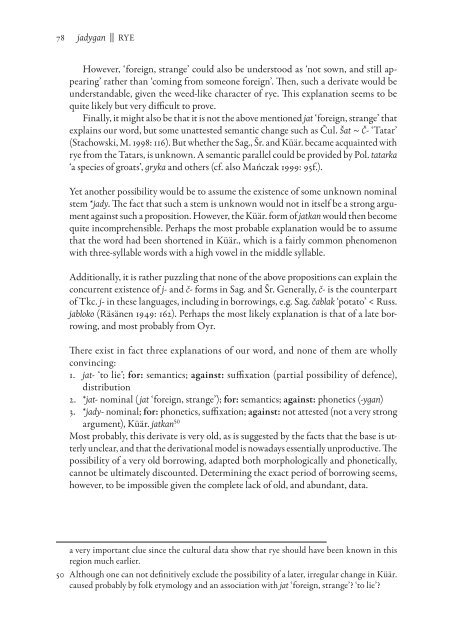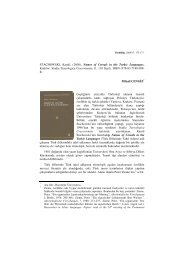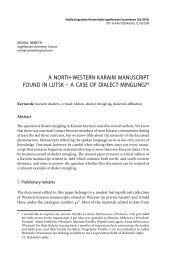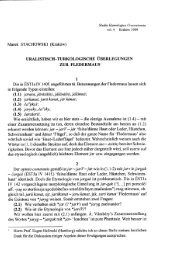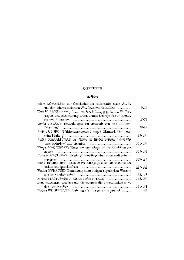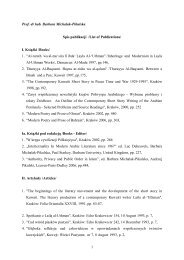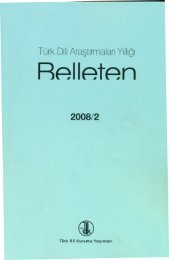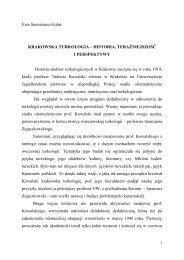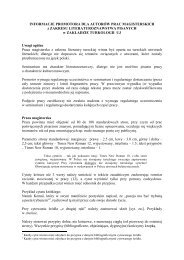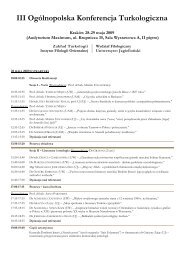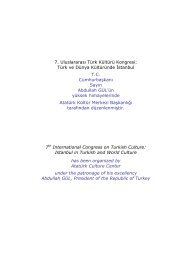Names of Cereals in the Turkic Languages - Wydział Filologiczny UJ
Names of Cereals in the Turkic Languages - Wydział Filologiczny UJ
Names of Cereals in the Turkic Languages - Wydział Filologiczny UJ
- No tags were found...
You also want an ePaper? Increase the reach of your titles
YUMPU automatically turns print PDFs into web optimized ePapers that Google loves.
78 jadygan || RyeHowever, ‘foreign, strange’ could also be understood as ‘not sown, and still appear<strong>in</strong>g’ra<strong>the</strong>r than ‘com<strong>in</strong>g from someone foreign’. Then, such a derivate would beunderstandable, given <strong>the</strong> weed-like character <strong>of</strong> rye. This explanation seems to bequite likely but very difficult to prove.F<strong>in</strong>ally, it might also be that it is not <strong>the</strong> above mentioned jat ‘foreign, strange’ thatexpla<strong>in</strong>s our word, but some unattested semantic change such as Čul. Šat ~ Č- ‘Tatar’(Stachowski, M. 1998: 116). But whe<strong>the</strong>r <strong>the</strong> Sag., Šr. and Küär. became acqua<strong>in</strong>ted withrye from <strong>the</strong> Tatars, is unknown. A semantic parallel could be provided by Pol. tatarka‘a species <strong>of</strong> groats’, gryka and o<strong>the</strong>rs (cf. also Mańczak 1999: 95f.).Yet ano<strong>the</strong>r possibility would be to assume <strong>the</strong> existence <strong>of</strong> some unknown nom<strong>in</strong>alstem *jady. The fact that such a stem is unknown would not <strong>in</strong> itself be a strong argumentaga<strong>in</strong>st such a proposition. However, <strong>the</strong> Küär. form <strong>of</strong> jatkan would <strong>the</strong>n becomequite <strong>in</strong>comprehensible. Perhaps <strong>the</strong> most probable explanation would be to assumethat <strong>the</strong> word had been shortened <strong>in</strong> Küär., which is a fairly common phenomenonwith three-syllable words with a high vowel <strong>in</strong> <strong>the</strong> middle syllable.Additionally, it is ra<strong>the</strong>r puzzl<strong>in</strong>g that none <strong>of</strong> <strong>the</strong> above propositions can expla<strong>in</strong> <strong>the</strong>concurrent existence <strong>of</strong> j- and č- forms <strong>in</strong> Sag. and Šr. Generally, č- is <strong>the</strong> counterpart<strong>of</strong> Tkc. j- <strong>in</strong> <strong>the</strong>se languages, <strong>in</strong>clud<strong>in</strong>g <strong>in</strong> borrow<strong>in</strong>gs, e.g. Sag. čablak ‘potato’ < Russ.jabloko (Räsänen 1949: 162). Perhaps <strong>the</strong> most likely explanation is that <strong>of</strong> a late borrow<strong>in</strong>g,and most probably from Oyr.There exist <strong>in</strong> fact three explanations <strong>of</strong> our word, and none <strong>of</strong> <strong>the</strong>m are whollyconv<strong>in</strong>c<strong>in</strong>g:1. jat- ‘to lie’; for: semantics; aga<strong>in</strong>st: suffixation (partial possibility <strong>of</strong> defence),distribution2. *jat- nom<strong>in</strong>al ( jat ‘foreign, strange’); for: semantics; aga<strong>in</strong>st: phonetics (-ygan)3. *jady- nom<strong>in</strong>al; for: phonetics, suffixation; aga<strong>in</strong>st: not attested (not a very strongargument), Küär. jatkan 50Most probably, this derivate is very old, as is suggested by <strong>the</strong> facts that <strong>the</strong> base is utterlyunclear, and that <strong>the</strong> derivational model is nowadays essentially unproductive. Thepossibility <strong>of</strong> a very old borrow<strong>in</strong>g, adapted both morphologically and phonetically,cannot be ultimately discounted. Determ<strong>in</strong><strong>in</strong>g <strong>the</strong> exact period <strong>of</strong> borrow<strong>in</strong>g seems,however, to be impossible given <strong>the</strong> complete lack <strong>of</strong> old, and abundant, data.a very important clue s<strong>in</strong>ce <strong>the</strong> cultural data show that rye should have been known <strong>in</strong> thisregion much earlier.50 Although one can not def<strong>in</strong>itively exclude <strong>the</strong> possibility <strong>of</strong> a later, irregular change <strong>in</strong> Küär.caused probably by folk etymology and an association with jat ‘foreign, strange’? ‘to lie’?


